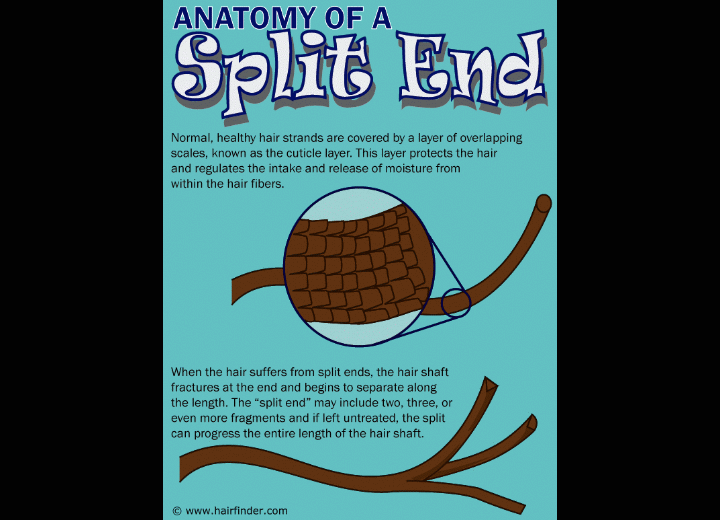What Split Ends Look Like

Q: What do split ends look like?
A: This is a great question because people very often mistake split ends for frizzy hair or regular hair breakage. As you can see in the graphic accompanying this question, a split end is just what it sounds like. The end of a hair strand is damaged resulting in the strand separating into two or more fragments.
You also need to remember that because the hair strands that extend out the scalp are made of this keratinized protein (like our nails) the hair strands are NOT alive and therefore cannot be “healed” or repaired except in the sense that you repair a piece of broken pottery by gluing it back together.
In fact, the glue analogy is very apt for this topic. You can “fix” split ends by using a protein shampoo and smoothing products that will cause the fragmented ends to adhere to one another again. This only repairs the appearance of the hair. If you want to get rid of split ends completely, you have to trim the hair off above the point at which the hair split.
Let me reiterate that split ends ONLY occur at the ends of the hair strand. I’ve had countless clients come to me complaining that they have split ends, only to sit down before me with longer, blunt cut styles with random hairs poking out all over their heads about mid-length of the silhouette.
Invariably, talking with them has revealed that they are pretty vigorous in brushing their hair, especially first thing in the morning or just out of the shower when they need to get little tangles and snarls out. What they end up doing is stretching and breaking the hair off which leaves behind a shorter strand that has been distressed and distorted. These strands don’t want to lie smoothly with the rest of the hair because they aren’t smooth any more. Their cuticle layers are skewed, and the hair strand is in trauma.
Split ends are always found at the bottom edge of a cutting line. In cases where the hair style is layered, then you usually find split ends at the areas where the hair is thinnest, because the ends of the hair there lack other hair to help keep it strong and protected. To confirm split ends use a magnifying lens (or strong reading glasses) and examine the ends of the hair. You should clearly see the fraying of the ends of the hair. If the whole head seems unruly and unwilling to lie smoothly together, then you’re dealing with frizz, not split ends. There is a difference.
©Hairfinder.com
See also:
Split-Ender
Why and how to trim long hair
How to repair split ends
Do split ends stop your hair from growing?